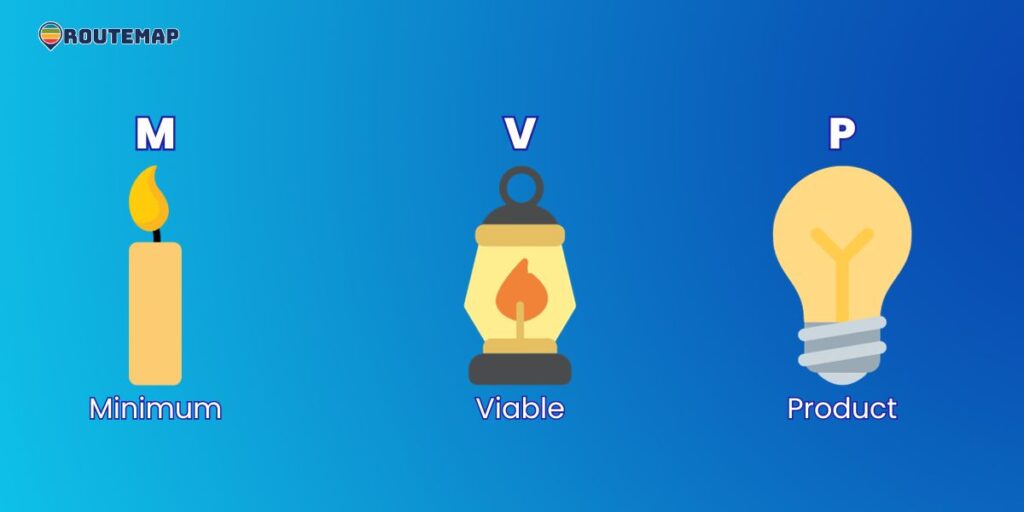The concept of the Minimum Viable Product has become a cornerstone in the world of modern business and product development. It represents a strategy that balances the need for efficient, cost-effective product development with the necessity of making a significant impact in the market.
In this article, we will show what an MVP truly entails, its place within Agile methodologies, and the best practices for defining and executing an MVP in product management.
Table of Content
What is a Minimum Viable Product or MVP in short?
At its core, an MVP is a product iteration that enables a team to glean the maximum amount of validated learning about customers with minimal effort. This strategy stands in stark contrast to traditional product development paradigms that prioritize the creation of feature-rich products before launch.

The MVP approach, conversely, concentrates on fundamental, indispensable features that suffice to engage early adopters and procure critical feedback for future enhancements.
The origin and evolution of the MVP concept
Rooted in lean startup methodologies, the MVP concept has evolved as an integral strategy for startups seeking to mitigate risks and optimize resource utilization. Within Agile frameworks, the MVP assumes a pivotal role, underpinning a nimble, iterative development process.
As a result, this methodology enables swift adaptation to evolving market demands and customer feedback, circumventing the drawbacks of overdevelopment and misalignment with market needs.
MVP in Agile: A synergistic relationship
In Agile methodologies, MVPs represent a practical embodiment of iterative development. This symbiosis facilitates rapid prototyping and continuous reassessment of a product’s trajectory, based on tangible market feedback.
Additionally, integrating MVP principles within Agile processes results in a more dynamic and responsive approach to product development. It also ensures alignment with customer expectations and market demands.
The benefits of using MVP in product management
The use of MVP in product management offers several significant benefits that can dramatically influence the success and efficiency of a product’s development and market launch.
1. Minimum Viable Product reduces risks
MVPs allow for testing product concepts with minimal resources before committing to full-scale development. By launching a product with only essential features, companies can gauge market reactions early on. As a result, it can reduce the risk of investing heavily in a product that may not resonate with the target audience.
2. MVP improves the time to market
By focusing on core functionalities, a Minimum Viable Product can be developed and introduced to the market more quickly than a fully-featured product. Moreover, this expedited time to market means companies can begin learning from real customer interactions sooner, giving them a competitive advantage.
3. It generates feedback and validation
One of the most significant advantages of an MVP is the ability to gather valuable feedback from early adopters. This feedback is critical for validating the product concept and understanding what resonates with the audience.
Besides, it also helps in identifying potential improvements or pivots needed for the product.
4. Minimum Viable Product provides cost-efficiency
Developing an MVP requires fewer resources than a complete product, both in terms of time and money. This efficiency is particularly advantageous for startups and smaller companies with limited budgets, allowing them to test their ideas without significant financial strain.
5. Agile MVP offers flexibility and adaptability
The iterative nature of MVP development allows for greater flexibility and adaptability. Based on the feedback and market response, product managers can make informed decisions about changing or enhancing the product. It will also ensure that it evolves in line with customer needs and preferences.
6. Build a user base and market presence
Launching an MVP helps in establishing a user base and market presence early in the product life cycle. Early adopters can become loyal customers and brand advocates, spreading the word and helping to build a market for the product.
7. Build investor and stakeholder confidence
Demonstrating a working MVP can be instrumental in building confidence among investors and stakeholders. It shows that the product concept is viable and has market potential, which can be crucial for securing further funding or support.
How to define your Minimum Viable Product
Defining a Minimum Viable Product is a sophisticated process including strategic market insights, an in-depth understanding of customer needs, and a clear product vision.
Therefore, this critical phase in MVP development is where theoretical concepts meet practical application, guiding the creation of a product that is both viable and valuable.
1. Establish core features
At the outset of defining an MVP, the primary focus should be on identifying the core features that are fundamental to the product’s purpose. This involves a meticulous process of distillation, where the product is stripped down to its essence, focusing solely on the features necessary to solve the primary problem it addresses.
Moreover, employing a prioritization matrix can be immensely beneficial during this phase. It assists in distinguishing the indispensable “must-have” features from the “nice-to-have” elements, ensuring that the Minimum Viable Product remains lean yet effective.
Get prioritization for your projects on Jira Streamline your tasks & workflow Try Routemap for Free |
2. Conduct thorough market research
Conducting thorough market research is imperative to understand the specific needs and pain points of the target audience. This stage should encompass a range of activities including customer interviews, surveys, and detailed market analysis to collect robust, actionable data.
Additionally, a competitive analysis is crucial. By evaluating existing market solutions and identifying gaps or areas of improvement, this analysis can offer insights into how to position the MVP for maximum impact
3. Set clear objectives and success metrics
Clearly defined objectives and success metrics are the cornerstones of an effective MVP. It’s essential to articulate the specific goals of the MVP, whether it’s testing a market hypothesis, validating demand for a product feature, or something else.
Besides these objectives, establishing measurable success metrics is equally important. Moreover, these metrics can gauge the MVP’s success and provide valuable insights for future iterations.
4. Balance the scope and resources
Managing the scope and resources efficiently is another critical aspect of defining an MVP. Scope management requires a vigilant eye to keep the MVP aligned with its intended objectives, avoiding the pitfall of feature creep.
Meanwhile, resource allocation must be judicious, balancing the development costs and timeframes against the need to achieve meaningful learning outcomes from the MVP.
5. Incorporate feedback loops
Without a doubt, incorporating feedback loops into the MVP is vital. Designing the product in a way that facilitates the effective collection of user feedback allows for continuous improvement.
Additionally, you can achieve this through integrated analytics tools, user feedback channels, or post-use interviews. An iterative development approach, fueled by this feedback, enables the product to evolve based on real user insights and market dynamics.
Challenges in Minimum Viable Product development
Developing an MVP in business is not without its challenges. One common pitfall is losing sight of the MVP’s minimalism, leading to feature creep.
It’s essential to strike a balance between simplicity and meeting consumer expectations. Furthermore, businesses must be ready to adapt their agile MVP based on feedback and market changes. This sometimes means significant pivots in strategy.
Final thoughts
The Minimum Viable Product approach is more than a product development strategy; it’s a mindset that prioritizes learning and adaptability. By balancing efficiency with impact, MVP in business offers a pragmatic pathway for startups and established businesses alike to innovate and succeed in today’s fast-paced market.
As the business landscape continues to evolve, the art of mastering MVPs will undoubtedly become an increasingly vital skill.






